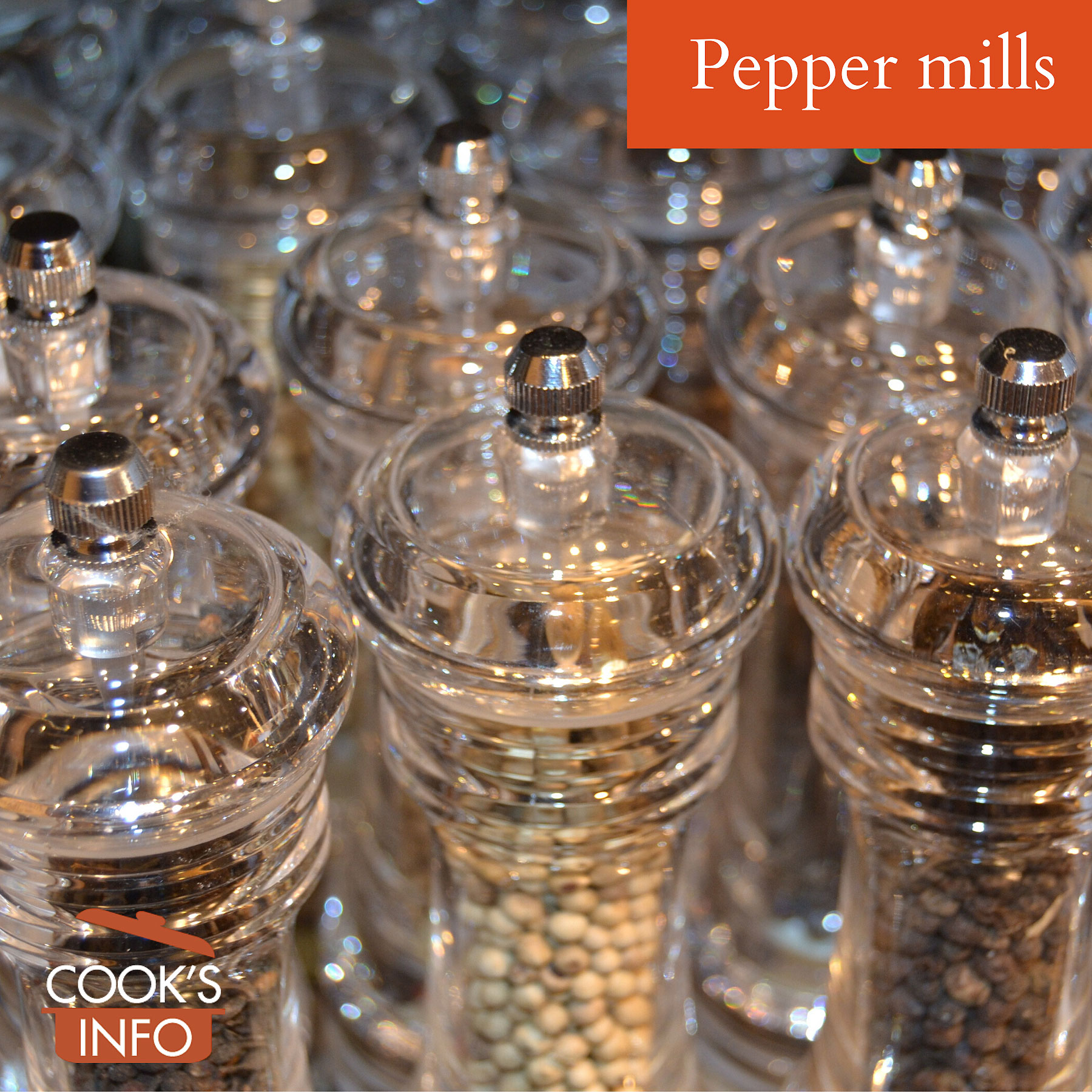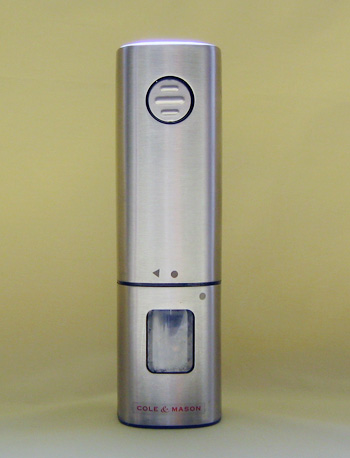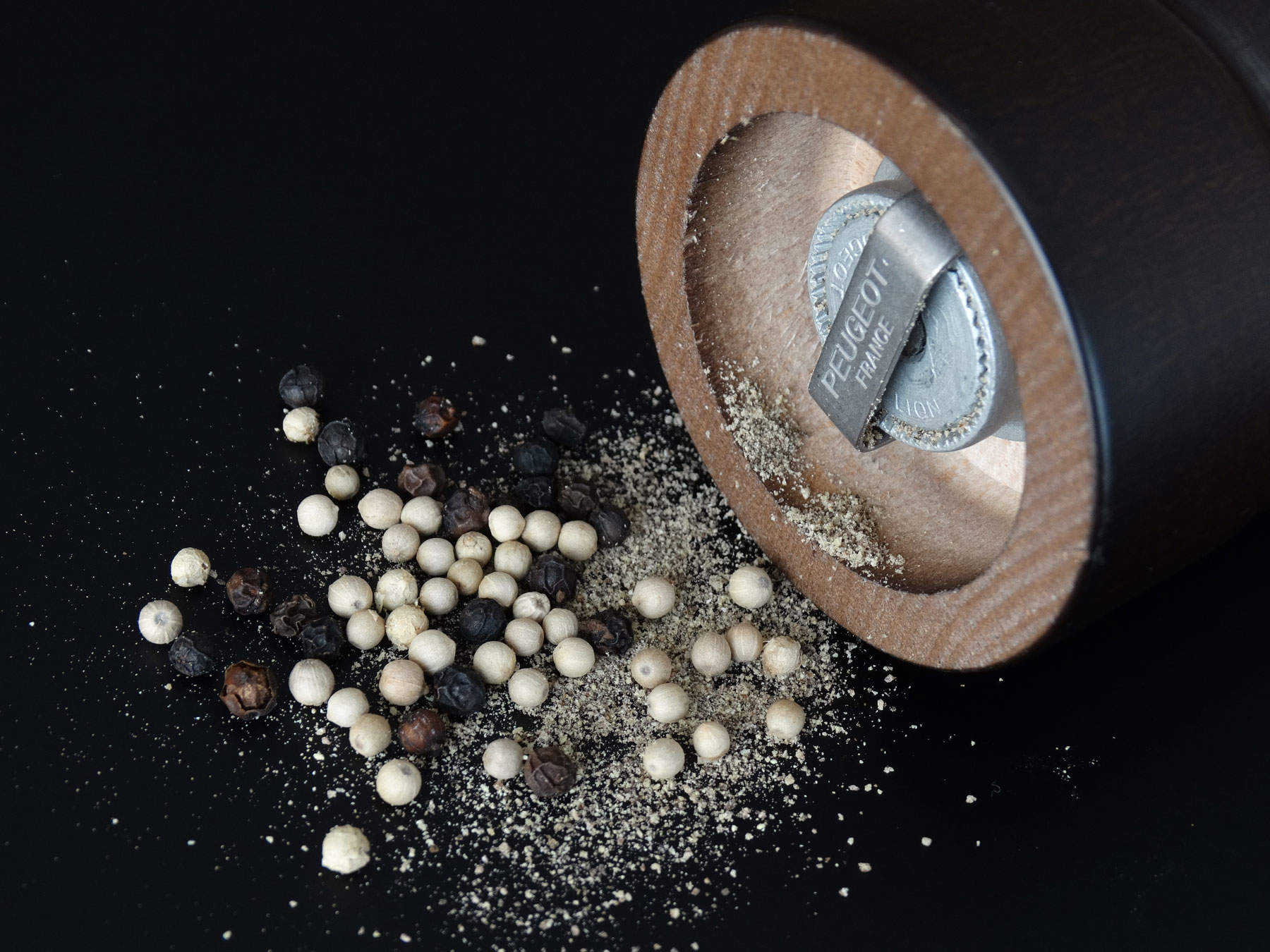
Acrylic pepper mills. Norbert Höldin / Pixabay.com / 2016 / CC0 1.0
Pepper mills are tools for converting whole peppercorns to ground pepper in the home as needed, on the fly.
Pepper mill construction
Almost all will be essentially cylindrical, and have the whole peppercorns in them at the top. Gravity causes the peppercorns to pass down through the grinder mechanism, and then as they as pass through, become ground pepper which falls out the bottom of the mill.
Some pepper mills have a cap at the bottom which holds the ground pepper until you release it.
They can be made of wood, plastic, or metal, and be manually or battery-operated.
The grinding mechanisms inside will be ceramic or steel: each has its advantage. Ceramic is more adjustable and responds more precisely when you adjust it. A steel mechanism can slice peppercorns more than it does grind them, giving more coarseness in the resultant ground pepper. In fact, some advertise that they “chop” peppercorns rather than just merely “grind” them as a feature.
It can be hard to get replacement mechanisms, but there are some third-party suppliers.
Manual vs electric
Manual ones are made with a variety of crank mechanisms. Some have actual handles that you crank; some have handles you squeeze together. The most basic one is a pepper mill made of wood, with a wooden top that you turn that cranks the grinding mechanism inside. On these ones, though, the lids often work themselves loose every two or three grinds, so you have to stop to tighten it again.

Classic manual wooden pepper mill. Tee Farm / Pixabay.com / 2016 / CC0 1.0
Electronic ones (i.e. battery-operated ones) are great for those with failing hands.
Many battery ones have built-in flashlights at the bottom, which are useful and fun at candlelit dinner parties.

Battery operated pepper mill. © Denzil Green / 2005
Adjusting the coarseness of the grind
When choosing a pepper mill, make sure you can adjust the grind from fine to coarse. Some models have you adjust the grinding mechanism inside via a knob at the top, the same knob you use to remove the top for filling. Others adjust via a screw or wheel at the bottom.
Some pepper mills have the flaw that the screw that you use to adjust the grinding mechanism inside always comes loose. A few just become harder and harder to crank until they jam completely and you have to disassemble them.
Buying a pepper mill
Before buying a pepper mill, take it apart and try to picture how hard it will be to fill. Is there a narrow opening that causes you to picture two-thirds of the peppercorns missing it and rolling all over the kitchen floor? How hard is it going to be to get a substantial quantity of ground pepper out, if you plan to be grinding 2 and 3 teaspoons at a time to use in cooking?
Some pepper mills can be used as a salt grinder, but only if they have ceramic grinding mechanisms — salt will corrode any metal parts. Still, you have to be sure that the ceramic grinding mechanisms are even then up to grinding hard salts like rock salts. If you’re not sure, then buy a grinder actually certified to be a salt grinder. There is no rule that says pepper grinders have to match the salt grinder.
Some pepper mills are designed to make fashion statements. Some very stylish ones, though, actually hold fewer peppercorns than their more workday cousins, so they seem to always be needing filling. Clear, acrylic pepper mills tend to get cloudy over time.
You can also buy peppercorns now packaged in plastic disposable grinder bottles.
Cooking Tips
Don’t fill a pepper mill completely full. Always allow some room at the top for the peppercorns to move up and down as they are being ground.
History Notes
Some sources claim that pepper mills were invented by Peugeot in France in 1842.
However, in the 1980s two pepper mills were recovered from the Mary Rose (capsized and sank 1545; excavated and raised 1983.) One pepper mill, Mary Rose inventory item # 81A1219 was made of cherrywood; the other, item # 81A3290 was made of ash.

Peugeot wooden pepper mill with varied peppercorns. 422737 / Pixabay.com / 2015 / CC0 1.0

